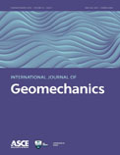
International Journal of Geomechanics
Scope & Guideline
Unveiling the complexities of earth structures and soil behavior.
Introduction
Aims and Scopes
- Soil and Rock Mechanics:
Research on the mechanical behavior of soils and rocks, including their strength, deformation, and failure mechanisms under different loading conditions. - Geotechnical Engineering Applications:
Studies focusing on practical applications of geomechanics in engineering projects, such as foundations, slopes, tunnels, and retaining structures. - Numerical Modeling and Simulation:
Development and application of numerical methods and computational models to simulate geomechanical processes and predict the behavior of geotechnical systems. - Experimental Investigations:
Laboratory and field experiments aimed at understanding the physical and mechanical properties of soils and rocks, as well as their interactions with structures. - Environmental Geomechanics:
Research that addresses the impact of environmental factors, such as water flow, temperature changes, and chemical interactions, on soil and rock behavior. - Innovative Materials and Techniques:
Exploration of new materials, such as biocemented soils and polymer-modified materials, and their geotechnical applications.
Trending and Emerging
- Advanced Numerical Methods:
Increased focus on cutting-edge numerical techniques, such as machine learning and hybrid modeling approaches, to enhance the predictive capabilities for complex geomechanical problems. - Sustainable Geotechnics:
Growing interest in sustainable practices, including the use of recycled materials and eco-friendly stabilization techniques, to mitigate environmental impacts in geotechnical engineering. - Seismic Response Analysis:
Heightened attention to the seismic behavior of structures, particularly in the context of soil-structure interaction during dynamic loading events. - Hydromechanical Coupling:
Emerging research on the interaction between hydraulic and mechanical processes, particularly in unsaturated soils and during consolidation processes. - Behavior of Biocemented and Modified Soils:
Increasing studies on biocementation and innovative soil modification techniques, focusing on their mechanical properties and applications in geotechnical projects. - Impact of Climate Change on Geotechnics:
Research addressing the implications of climate change on soil behavior, including effects of extreme weather events on slope stability and foundation performance.
Declining or Waning
- Traditional Soil Mechanics:
Research centered on classical soil mechanics principles, such as Mohr-Coulomb failure criteria and consolidation theory, has become less prominent as newer methodologies and materials gain traction. - Static Analysis of Structures:
Focus on static analysis methods for soil-structure interaction has waned, with a noticeable shift towards dynamic and time-dependent analyses. - Conventional Excavation Techniques:
Studies on traditional excavation methods and their geomechanical implications have decreased as the field moves towards more advanced, innovative excavation technologies. - Simplistic Models in Geomechanics:
The reliance on overly simplistic models for predicting geomechanical behavior is declining as researchers favor more complex, realistic models that account for multiple parameters and interactions.
Similar Journals
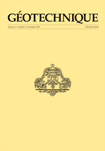
GEOTECHNIQUE
Transforming Insights into Engineering ExcellenceGEOTECHNIQUE is a prestigious peer-reviewed journal published by Emerald Group Publishing Ltd, specializing in the fields of Geotechnical Engineering and Earth and Planetary Sciences. Established in 1948, this journal has consistently delivered groundbreaking research and advancements in the science of soil and rock mechanics, engineering geology, and environmental applications, aiming to foster innovation in geotechnical practices. With an impressive impact factor reflected in its Q1 ranking within both the Earth and Planetary Sciences and Geotechnical Engineering categories, GEOTECHNIQUE is recognized as a leading source of scholarly articles, positioning itself among the top 5% in the field. The journal is accessible via subscription, providing a repository of invaluable insights for researchers, professionals, and students striving to push the boundaries of knowledge and application in geotechnical topics. With a robust editorial board and a commitment to excellence, GEOTECHNIQUE continues to contribute significantly to the academic community and the practical engineering landscape.
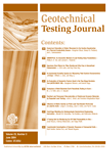
GEOTECHNICAL TESTING JOURNAL
Transforming Geotechnical Challenges into Engineering SolutionsGEOTECHNICAL TESTING JOURNAL, published by the American Society for Testing and Materials, is a premier peer-reviewed journal dedicated to the advancement of geotechnical engineering and engineering geology. With an ISSN of 0149-6115 and E-ISSN 1945-7545, this journal has been a cornerstone in the field since its inception in 1978, spanning volumes released until 2024. Ranked in the Q2 category of the 2023 journal metrics, the journal stands as a significant contributor to Earth and Planetary Sciences, particularly in geotechnical applications, as evidenced by its Scopus rank of #102 out of 229, placing it in the 55th percentile across the database. Offering a wealth of empirical research, technical notes, and innovative practice insights, the GEOTECHNICAL TESTING JOURNAL aims to bridge the gap between theory and practical application, making it an invaluable resource for researchers, professionals, and students eager to contribute to and advance the field of geotechnical engineering.
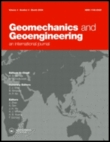
Geomechanics and Geoengineering-An International Journal
Pioneering Research in Geomechanics and GeoengineeringGeomechanics and Geoengineering-An International Journal, published by Taylor & Francis Ltd, serves as a prominent platform for the dissemination of innovative research and advancements in the fields of Geotechnical Engineering and Engineering Geology. With an ISSN of 1748-6025 and E-ISSN of 1748-6033, this journal has established itself as a critical resource within its category, ranking in the Q2 quartile according to the 2023 metrics and positioning itself in the top 38% of the Scopus rankings for Earth and Planetary Sciences. Geomechanics and Geoengineering encompasses a diverse range of topics, including but not limited to soil mechanics, foundation engineering, rock mechanics, and environmental geotechnics, ultimately aiming to advance both theoretical and practical knowledge in these vital areas. This journal not only highlights pioneering research but also facilitates a platform for academia and industry practitioners to collaborate and exchange ideas. While it does not offer open access, it remains a valuable resource for institutions and individuals committed to enhancing their expertise in the geotechnical domain. With convergence years spanning from 2006 to 2024, this journal is equipped to significantly contribute to the evolving landscape of geomechanical research.
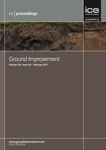
Proceedings of the Institution of Civil Engineers-Ground Improvement
Unveiling Innovations in Ground Improvement TechnologiesProceedings of the Institution of Civil Engineers-Ground Improvement is a distinguished journal published by EMERALD GROUP PUBLISHING LTD, dedicated to advancing knowledge and research in the fields of Building and Construction, Geotechnical Engineering, Mechanics of Materials, and Soil Science. With an ISSN of 1755-0750 and an E-ISSN of 1755-0769, this journal has been a vital platform for disseminating innovative research since its inception in 2008. With an impact factor placing it in the Q3 category across multiple engineering disciplines, it ranks favorably in Scopus, ensuring visibility and recognition among scholars globally. The journal offers open access options, allowing for broader dissemination of research findings. Targeting researchers, professionals, and students alike, it aims to foster discussions on ground improvement technologies and methodologies that are essential for sustainable infrastructure development. As it continues to converge its focus until 2024, the Proceedings stands as an imperative resource for those seeking to elevate their understanding and contribute to the ever-evolving field of civil engineering.

Geotechnical Research
Bridging theory and practice in earth sciences.Geotechnical Research is an esteemed scholarly journal published by EMERALD GROUP PUBLISHING LTD, dedicated to advancing the field of geotechnical engineering and earth sciences. With an impact factor reflective of its robust contributions, this open access journal has been providing unrestricted access to high-quality research since 2014, making it indispensable for researchers, professionals, and students alike. The journal, indexed under the ISSN 2052-6156, features rigorous peer-reviewed articles that encompass a wide range of topics within geotechnical engineering and engineering geology, achieving a notable placement in the Q2 category in both Earth and Planetary Sciences and Geotechnical Engineering as of 2023. With its Scopus ranks further affirming its significance—ranked #44 out of 159 in Earth and Planetary Sciences and #78 out of 229 in Geotechnical Engineering—Geotechnical Research stands as a vital resource for innovative solutions and advancements in this critical field, ensuring researchers access to essential insights that drive the discipline forward.

Studia Geotechnica et Mechanica
Innovating Civil Engineering Through Open Access ResearchStudia Geotechnica et Mechanica is a distinguished academic journal dedicated to the vital fields of geotechnics, civil engineering, and materials science. Published by SCIENDO, this Open Access journal has been facilitating unrestricted access to research since 2012, allowing for wide dissemination of innovative findings and methodologies. Based in Poland, it contributes significantly to the scholarly community by providing a platform for the exchange of ideas, techniques, and advancements relevant to Civil and Structural Engineering, Geotechnical Engineering, and related disciplines. With an increasing emphasis on applied research, Studia Geotechnica et Mechanica is classified in various quartiles, demonstrating its emerging influence in fields such as Computers in Earth Sciences and Mechanics of Materials. The journal is indexed in Scopus, showcasing its commitment to maintaining high academic standards. By publishing peer-reviewed research articles, this journal is essential for researchers, professionals, and students looking to stay at the forefront of developments in these critical areas of engineering and science.
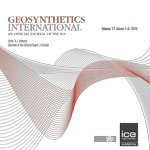
GEOSYNTHETICS INTERNATIONAL
Leading the Charge in Geotechnical InnovationGEOSYNTHETICS INTERNATIONAL, published by EMERALD GROUP PUBLISHING LTD, is a leading journal in the fields of Civil and Structural Engineering and Geotechnical Engineering, recognized for its significant contributions since its inception in 1994. With an impressive impact factor reflecting its esteemed reputation—ranking in the top quartile (Q1) for both primary categories—this journal serves as a critical platform for the dissemination of cutting-edge research and innovations related to synthetic materials in geotechnical applications. Researchers, professionals, and students alike benefit from access to peer-reviewed articles that explore both theoretical advancements and practical implementations of geosynthetics, addressing complex engineering challenges and environmental considerations. Given its commendable rankings in Scopus, where it stands at Rank #73 in Civil and Structural Engineering and Rank #46 in Geotechnical Engineering, with an 80th percentile performance, the journal not only enhances scholarly dialogue but also influences industry practices. GEOSYNTHETICS INTERNATIONAL continues to play a pivotal role in shaping future directions in engineering and sustainability.

Soil Mechanics and Foundation Engineering
Elevating Standards in Foundation Engineering ResearchSoil Mechanics and Foundation Engineering, published by SPRINGER, is a prestigious academic journal dedicated to the dynamic fields of soil mechanics and foundation engineering. With a history spanning from 1964 to 2024, this journal serves as a vital platform for researchers, professionals, and students looking to advance their knowledge and explore innovative techniques in soil behavior, foundation design, and geotechnical engineering. Although the journal does not currently operate under an open access model, it remains essential for its contributions to key disciplines, notably in energy, geotechnical engineering, ocean engineering, soil science, and water science. Positioning itself in the third quartile of various categories in the 2023 rankings, it reflects a commitment to maintaining rigorous research standards despite its competitive environment. The unique intersection of its scope allows for multidisciplinary collaboration, making it an invaluable resource for those aiming to tackle the challenges in foundation systems and soil interactions in diverse engineering applications.

COMPUTERS AND GEOTECHNICS
Advancing Geotechnical Innovation through Computational Excellence.COMPUTERS AND GEOTECHNICS is a premier scholarly journal published by Elsevier Science Ltd, devoted to advancing the intersection of computer science and geotechnical engineering. With an impressive impact factor and categorically recognized as a Q1 journal in both Computer Science Applications and Geotechnical Engineering as of 2023, it stands at the forefront of research in its field. The journal has maintained a remarkable reputation since its inception in 1985, providing a dynamic platform for disseminating cutting-edge research, technological advancements, and innovative methodologies related to the application of computer science in geotechnics. Researchers, professionals, and students benefit from its rigorous peer-review process and high-quality publications, which demonstrate practical applications and theoretical foundations necessary for the relevant industries. Renowned for an extensive global readership, COMPUTERS AND GEOTECHNICS plays a critical role in fostering collaboration and development in tackling complex geotechnical challenges through computational methods, all while contributing to the broader understanding of environmental interactions. This journal provides essential insights and is instrumental for those at the cutting edge of this evolving discipline.
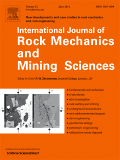
INTERNATIONAL JOURNAL OF ROCK MECHANICS AND MINING SCIENCES
Pioneering Research in Geotechnical Engineering and Mining.Welcome to the INTERNATIONAL JOURNAL OF ROCK MECHANICS AND MINING SCIENCES, an esteemed publication in the field of geotechnical engineering and engineering geology, published by PERGAMON-ELSEVIER SCIENCE LTD. With a commendable ISSN of 1365-1609 and an E-ISSN of 1873-4545, this journal stands as a critical resource for advancing scientific understanding within the disciplines associated with rock mechanics and the mining industry. Holding a prestigious Q1 category ranking in the 2023 metrics, the journal is positioned in the top tier of its field, demonstrating its impact in the research community, with a Scopus rank of 2 out of 229 and a remarkable 99th percentile recognition. Established in 1969, the journal aims to facilitate the exchange of high-quality research, encompassing innovative methodologies, practical applications, and theoretical advancements relevant to both academia and industry. While the journal does not currently offer open access, its extensive backlist and current issues are accessible through various academic databases, ensuring that vital knowledge is shared with a broad audience. The INTERNATIONAL JOURNAL OF ROCK MECHANICS AND MINING SCIENCES is not only a key platform for researchers and professionals but also a valuable educational resource for students aspiring to delve into the complexities of rock mechanics and mining practices.